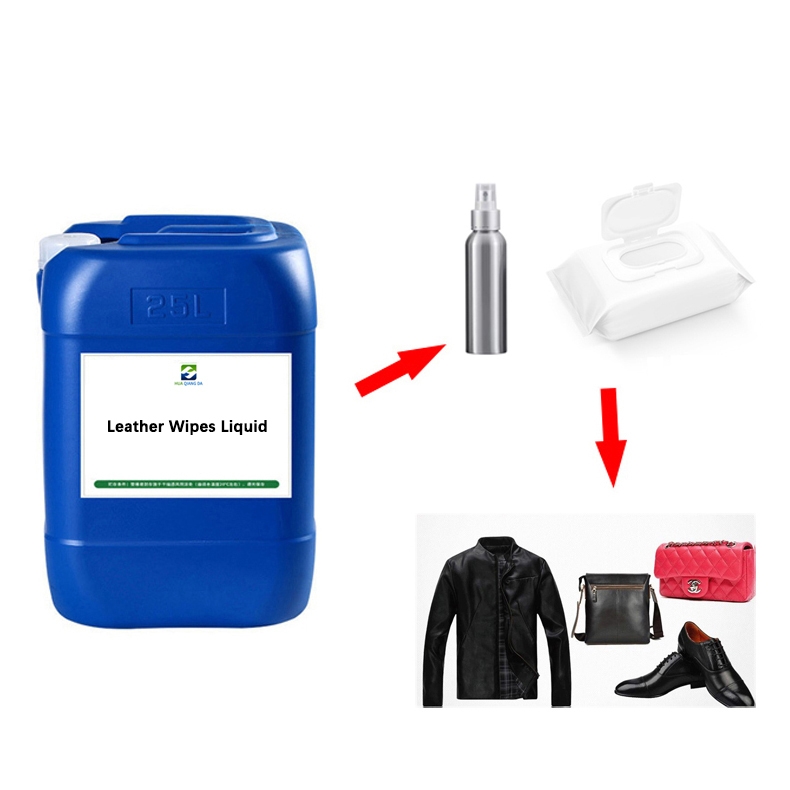
Leather care wet wipes liquids
1.1 Cleaning Type
- Key Ingredients: Mainly surfactants (e.g., APG, betaine-based), combined with ethanol or other solvents. Surfactant content typically ranges from 8% to 15%.
- Features: Focuses on removing dust, oils, and stains from leather surfaces, suitable for daily stain treatment (e.g., oil stains, sweat stains).
- Application Scenarios: Daily cleaning of leather shoes, bags, sofas, and other frequently used leather products.
1.2 Conditioning & Polishing Type
- Key Ingredients: Contains natural oils (lanolin, jojoba oil) and waxes (carnauba wax, beeswax), with oil/wax content ranging from 5% to 10%.
- Features: Moisturizes leather to prevent drying and cracking, while forming a protective film to enhance shine and water resistance.
- Application Scenarios: Maintenance of luxury leather (e.g., fine cowhide, sheepskin), leather furniture, and automotive leather.
1.3 Waterproof & Protective Type
- Key Ingredients: Includes silicone-based waterproof agents (e.g., polydimethylsiloxane) and film-forming agents (e.g., PVA), with waterproof additives accounting for 1% to 3%.
- Features: Creates a durable water-resistant layer, repels liquid penetration, and resists dust and scratches.
- Application Scenarios: Outdoor leather goods (e.g., boots, jackets), high-traffic leather in households or commercial spaces.
1.4 Antibacterial & Deodorizing Type
- Key Ingredients: Contains antimicrobial agents (e.g., phenoxyethanol, triclosan) and odor-neutralizing compounds (e.g., cyclodextrin), with antibacterial agents at 0.3% to 0.5%.
- Features: Kills bacteria, eliminates odors (e.g., sweat, pet odors), and prolongs leather freshness.
- Application Scenarios: Leather used in humid environments (e.g., sports gear, baby products), public seating, or pet accessories.
2. Classification by Leather Type
2.1 Smooth Leather (e.g., Cowhide, Sheepskin)
- Formula Features: Higher ethanol content (15%–25%) and waxes (5%–8%) for strong cleaning and high gloss.
- Application: Glossy leather shoes, handbags, and furniture.
2.2 Suede & Nubuck Leather
- Formula Features: Low-surfactant (≤8%), high-moisturizer (e.g., glycerin 5%) formulas to avoid damaging the nap.
- Application: 麂皮 boots, suede jackets, and luxury accessories.
2.3 Synthetic Leather (PU/PVC)
- Formula Features: Higher surfactants (10%–15%) and antistatic agents (e.g., quaternary ammonium salts) to prevent dust adhesion.
- Application: Inexpensive leather goods, automotive interiors, and furniture.
2.4 Delicate Leather (e.g., Aniline Leather, Baby Leather)
- Formula Features: Alcohol-free, gentle surfactants (e.g., glucosides), and natural oils (e.g., shea butter).
- Application: High-end leather products, vintage leather, and leather in direct contact with skin.
3. Classification by Formulation Characteristics
3.1 Alcohol-Based
- Features: Contains 10%–25% ethanol for fast-drying, antibacterial properties; suitable for oily leather or summer use.
- Caution: Not recommended for dry or aged leather.
3.2 Alcohol-Free
- Features: Uses water or plant-based solvents, enriched with moisturizers (e.g., propylene glycol); gentle for sensitive leather.
- Application: Aniline leather, suede, and winter care.
3.3 Eco-Friendly & Vegan
- Features: Plant-derived surfactants (e.g., coconut-based), biodegradable solvents, and no animal fats (e.g., synthetic waxes instead of beeswax).
- Application: Environmentally conscious consumers and cruelty-free leather products.
3.4 High-Temperature & Low-Temperature Resistant
- Features: Added stabilizers (e.g., xylitol) to prevent separation in extreme temperatures (e.g., -5°C to 50°C).
- Application: Automotive leather, outdoor gear, and industrial storage.
4. Classification by Usage Scenario
4.1 Daily Maintenance
- Features: Balanced cleaning and conditioning, moderate oil content (3%–5%).
- Application: Regular wipe-down of leather items in households or offices.
4.2 Deep Cleaning (Heavy-Duty)
- Features: High-surfactant (12%–15%) and low-oil formulas for stubborn stains (e.g., ink, grease).
- Caution: Use sparingly to avoid over-degreasing.
4.3 Travel & On-The-Go
- Features: Portable packaging, quick-drying formula (high ethanol content), and compact size.
- Application: Business trips, outdoor activities, and emergency stain removal.
4.4 Professional/Industrial
- Features: Concentrated formulas, high-performance additives (e.g., industrial-grade waxes), and large-batch packaging.
- Application: Leather manufacturing, restoration workshops, and hotel housekeeping.
5. Classification by Special Functions
5.1 Anti-Aging & UV Protection
- Features: Contains antioxidants (e.g., vitamin E, BHT) and UV absorbers (e.g., benzophenone), ideal for outdoor leather exposed to sunlight.
5.2 Static-Proof
- Features: Added antistatic agents (e.g., cationic surfactants) to reduce dust attraction on synthetic leather.
5.3 Infant & Pet Safe
- Features: Fragrance-free, hypoallergenic, and non-toxic ingredients (e.g., food-grade preservatives), suitable for baby products or pet beds.
This classification helps users select products based on their leather type, maintenance needs, and environmental preferences. Always test a small area before full application, especially for delicate or vintage leather.






 English
English
 USA
USA
 西班牙语
西班牙语
 俄罗斯
俄罗斯
 葡萄牙
葡萄牙
 印尼
印尼
 巴基斯坦
巴基斯坦
 尼日利亚
尼日利亚
 孟加拉
孟加拉
 墨西哥
墨西哥
 越南
越南
 日本
日本
 韩国
韩国

